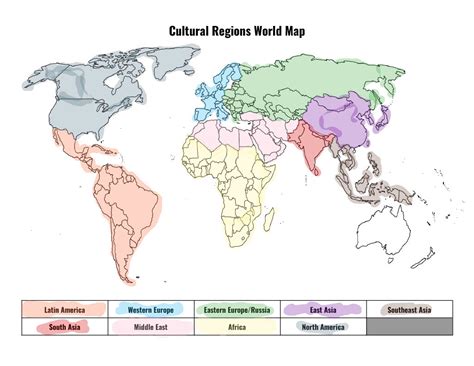The world is a vast and complex place, comprising numerous regions, each with its unique cultural, geographical, and economic characteristics. To better understand these differences and similarities, geographers and scholars often divide the world into distinct regions. One such approach is the Virginia Tech World Regions framework, which categorizes the world into seven distinct regions. In this article, we will delve into each of these regions, exploring their defining features, characteristics, and significance.
1. North America

Cultural Significance of North America
North America is often regarded as a melting pot of cultures, with a blend of indigenous, European, African, and Asian influences. The region is home to numerous world-renowned universities, research institutions, and cultural centers, making it a hub for innovation, entrepreneurship, and artistic expression.2. Middle America and the Caribbean

Economic Significance of Middle America and the Caribbean
The region is rich in natural resources, including oil, gas, and minerals, making it an important player in the global energy market. Additionally, the region's strategic location between North and South America makes it a crucial hub for international trade and commerce.3. South America

Cultural Significance of South America
South America is home to a rich cultural heritage, with influences from indigenous, European, African, and Asian communities. The region is known for its vibrant music, dance, and art, including salsa, tango, and samba.4. Europe

Economic Significance of Europe
Europe is one of the world's leading economic regions, with a highly developed infrastructure, a strong service sector, and a rich cultural heritage. The region is home to numerous international organizations, including the European Union, the United Nations, and the International Committee of the Red Cross.5. Russia and the Post-Soviet States

Cultural Significance of Russia and the Post-Soviet States
The region is home to a rich cultural heritage, with influences from Slavic, Mongol, and European communities. The region is known for its vibrant literature, music, and art, including the works of Tolstoy, Dostoevsky, and Tchaikovsky.6. North Africa and the Middle East

Economic Significance of North Africa and the Middle East
The region is rich in natural resources, including oil, gas, and minerals, making it an important player in the global energy market. Additionally, the region's strategic location between Europe, Asia, and Africa makes it a crucial hub for international trade and commerce.7. Sub-Saharan Africa

Cultural Significance of Sub-Saharan Africa
Sub-Saharan Africa is home to a rich cultural heritage, with influences from indigenous, European, Arab, and Asian communities. The region is known for its vibrant music, dance, and art, including Afrobeat, Highlife, and Juju.





We hope this article has provided you with a comprehensive understanding of the seven world regions as defined by Virginia Tech. Each region has its unique cultural, geographical, and economic characteristics, making our world a rich and diverse place.
If you have any questions or comments, please feel free to share them below. We would love to hear from you and continue the conversation.
What are the seven world regions defined by Virginia Tech?
+The seven world regions defined by Virginia Tech are: North America, Middle America and the Caribbean, South America, Europe, Russia and the Post-Soviet States, North Africa and the Middle East, and Sub-Saharan Africa.
What is the cultural significance of North America?
+North America is often regarded as a melting pot of cultures, with a blend of indigenous, European, African, and Asian influences. The region is home to numerous world-renowned universities, research institutions, and cultural centers, making it a hub for innovation, entrepreneurship, and artistic expression.
What is the economic significance of the Middle East?
+The Middle East is rich in natural resources, including oil, gas, and minerals, making it an important player in the global energy market. Additionally, the region's strategic location between Europe, Asia, and Africa makes it a crucial hub for international trade and commerce.
